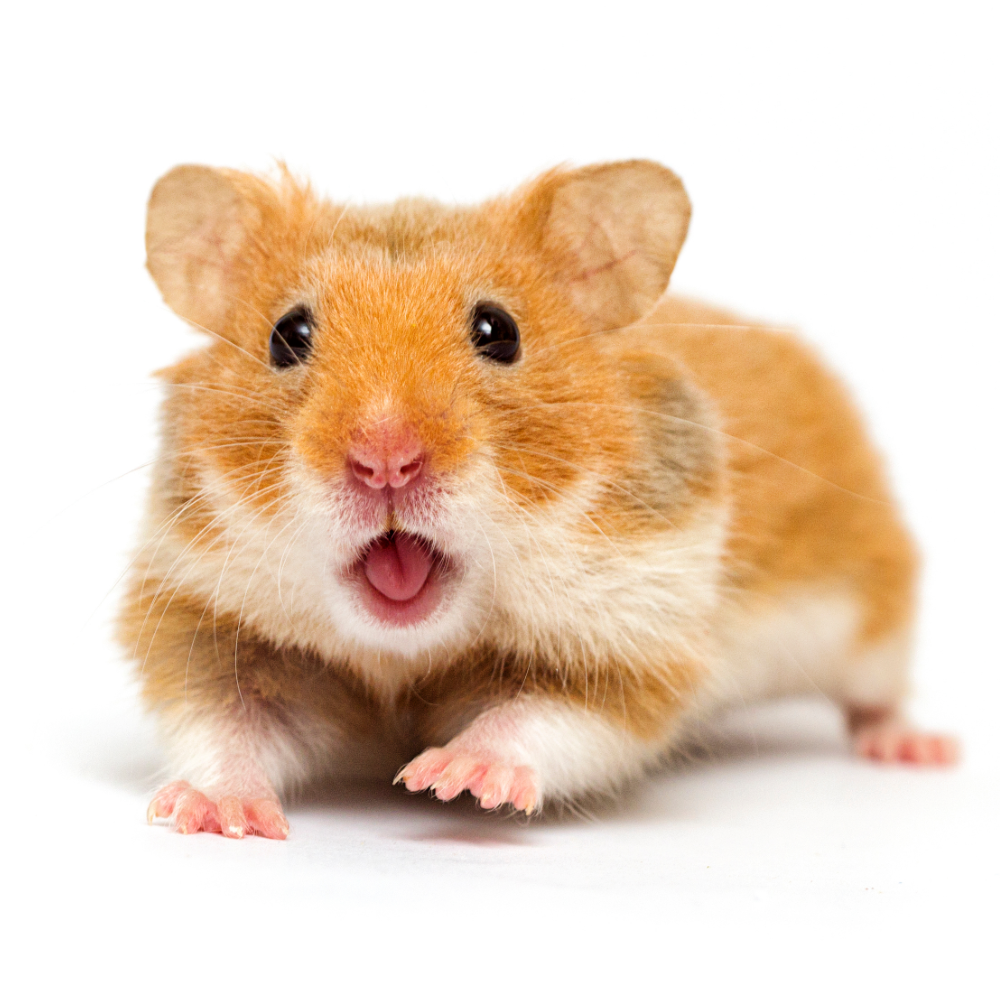 The Hamster (Mesocricetus auratus, Family Cricetidae, Order Rodentia) also called golden hamster is a small friendly rodent that is very popular in the Netherlands. The Syrian Hamster comes, as its name suggests, from Syria and the south of Turkey. The animals live there in dry steppe areas and clay soils, in which they dig beautiful holes and tunnels.
The Hamster (Mesocricetus auratus, Family Cricetidae, Order Rodentia) also called golden hamster is a small friendly rodent that is very popular in the Netherlands. The Syrian Hamster comes, as its name suggests, from Syria and the south of Turkey. The animals live there in dry steppe areas and clay soils, in which they dig beautiful holes and tunnels.
Head-body length : up to 18 cm
Body weight : up to 180 g (females are slightly heavier than males)
Life expectancy : 2 to 3 years
Syrian Hamsters are truly nocturnal. The animals sleep during the day and come out late in the evening to look for food. However, there is a difference between males and females. The females are more active than the males. Females also come out during the day sometimes.
Females need more challenge than males, if they get bored they can start to show problem behavior. A cage with bars is not recommended because Golden hamsters can quickly start to gnaw bars.
What is a hamster?
A golden hamster is another name for the Syrian hamster . This species is the largest of the domestic hamsters and originates from Syria. They owe their name to the golden wild color in which they were originally discovered.
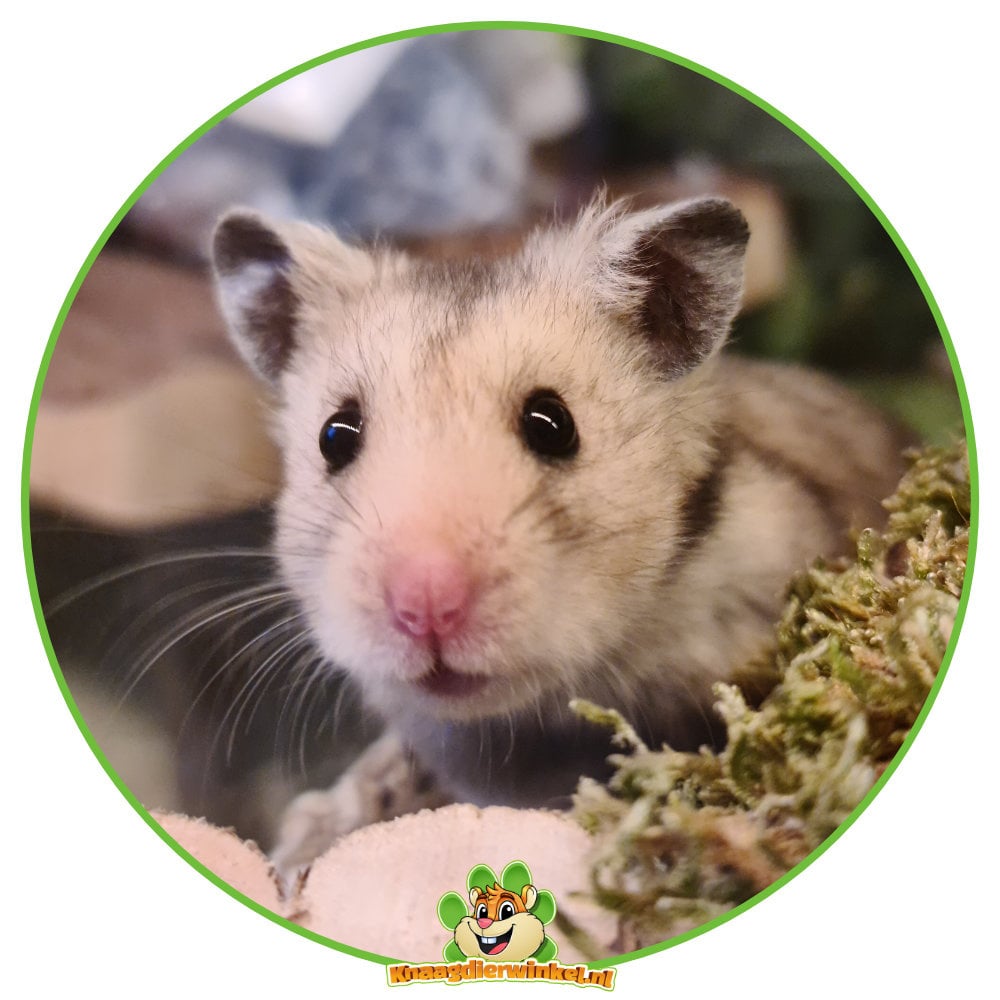
Can you keep golden hamsters together?
No, golden hamsters are strictly solitary . They should always be kept alone. Putting them together almost always leads to fighting.
How big should a cage be for a hamster?
For a golden hamster, a minimum cage size of 100x50 cm is recommended, with at least 20 cm of diggable substrate.
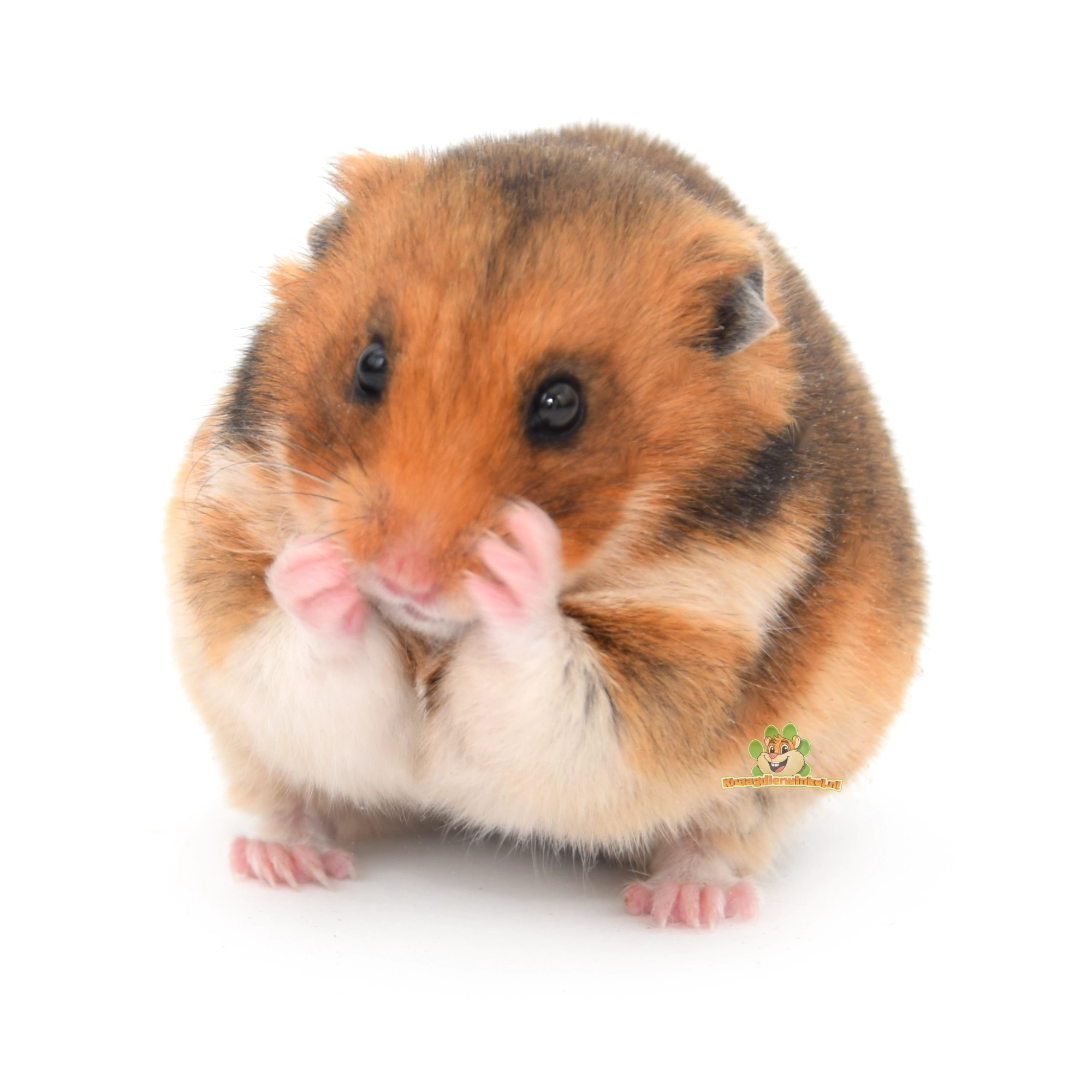 |
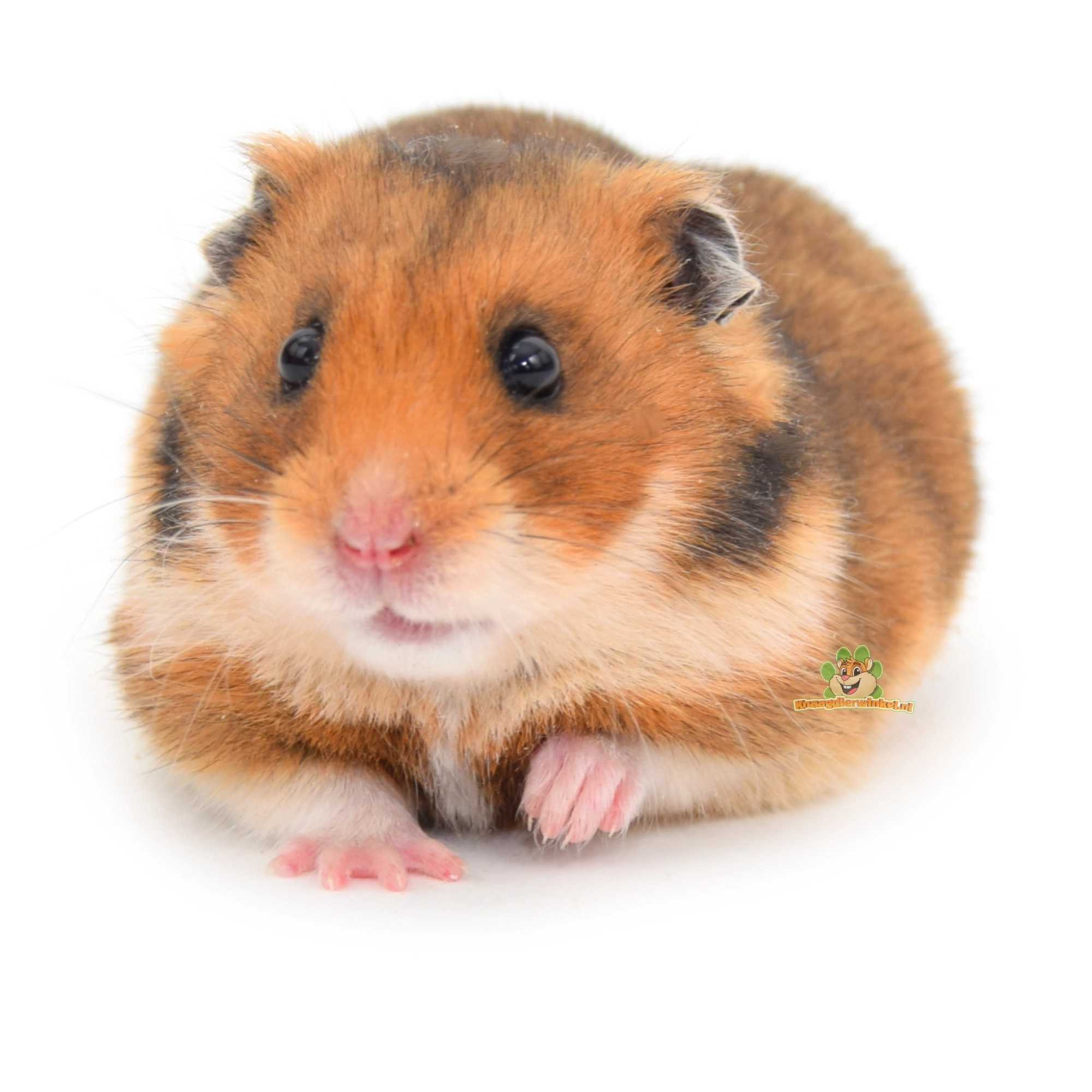 |
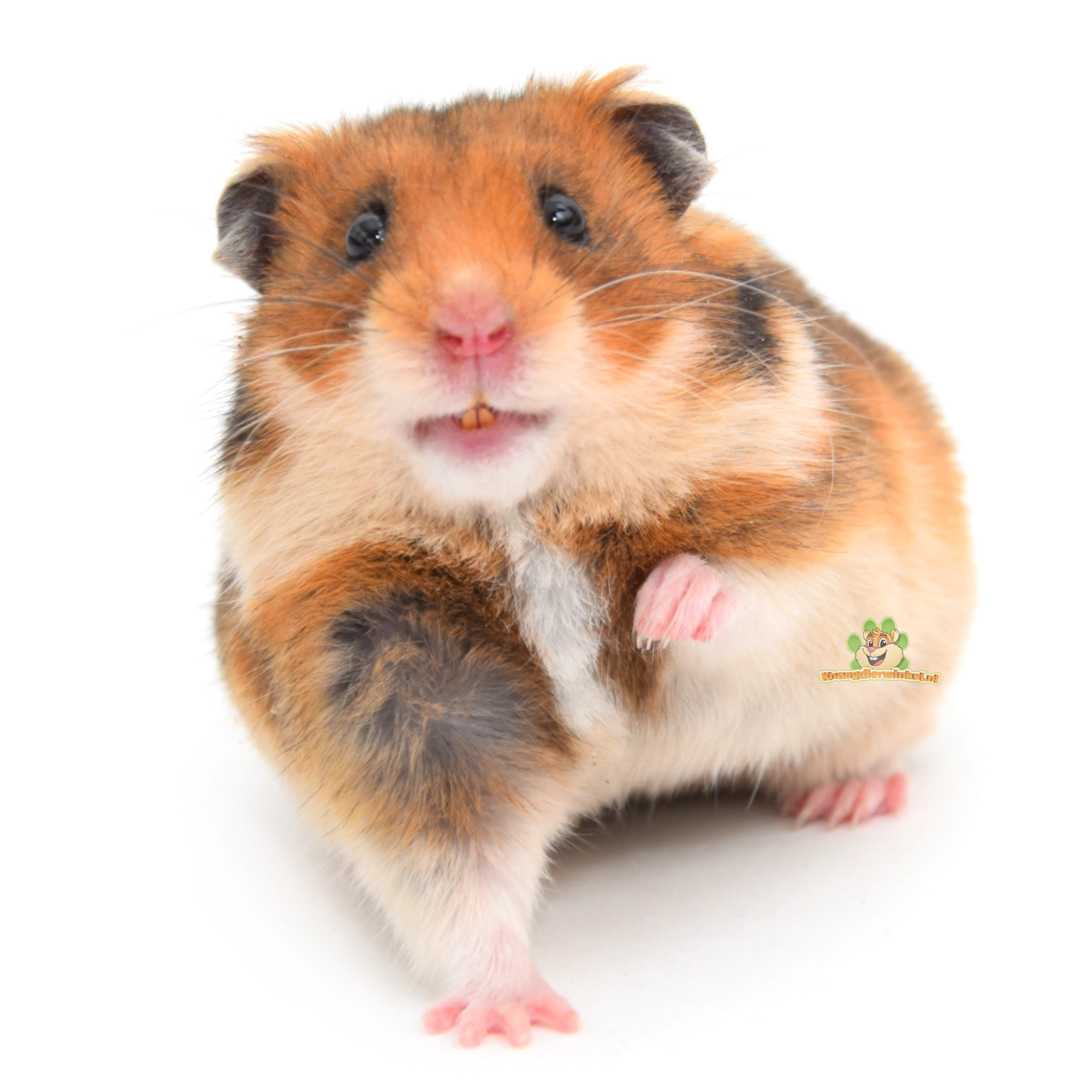 |
What is the difference between a Syrian and a dwarf hamster?
- Larger in size
- Easier to tame
- Should be kept alone
- Usually calmer behavior
What is a teddy hamster?
A teddy hamster is a long-haired variant of the Syrian hamster . Their soft and fluffy fur makes them look like a small teddy bear, hence the name.
Does a teddy hamster need coat care?
Teddy hamsters need more coat care than short-haired Syrian hamsters. Check regularly for tangles and dirt in the coat. For extreme tangles, you can gently brush with a small comb.
What is the best bedding for a teddy hamster?
Use dust-free and soft ground cover that is easy to dig, such as cotton fibre or hemp. Avoid sharp woods or dusty sawdust.
Does a hamster need care?
Yes, but this is relatively simple. Make sure:
- High quality nutrition
- Fresh drinking water daily
- A running wheel of at least 28 cm
- Ground cover for digging
- A sand bath for coat care
Taming and familiarizing the Syrian Hamster
 First read up on whether a Syrian Hamster is the right pet. It can be disappointing, especially for children, if it turns out that the hamster is only active when everyone is in bed. Of course, not every Golden Hamster has this rhythm, but unfortunately most do. This must be taken into account at all times. The animals should also not be woken up during the day, because this causes them stress, can become really grumpy and can even start biting.
First read up on whether a Syrian Hamster is the right pet. It can be disappointing, especially for children, if it turns out that the hamster is only active when everyone is in bed. Of course, not every Golden Hamster has this rhythm, but unfortunately most do. This must be taken into account at all times. The animals should also not be woken up during the day, because this causes them stress, can become really grumpy and can even start biting.
Although the Syrian Hamster looks very cuddly, he does not always like to cuddle and he finds being picked up very scary, especially in the beginning. Because the animals do not see depth, they can run away from your hand if they are frightened, so it is important when children handle the animals that there is always a parent present who can help and support.
A new resident should be approached calmly, especially at first. The animal must first become familiar with its own habitat and feel safe there before it dares to approach people. Of course, there are also daredevils who immediately approach you and are social, but most hamsters are still a bit shy at first. Give the animal time and try to make contact calmly by talking to the hamster. Giving a treat from the hand often works well to gain the trust of the animals.
Tip! Syrian hamsters love pumpkin seeds.
Housing the Syrian Hamster
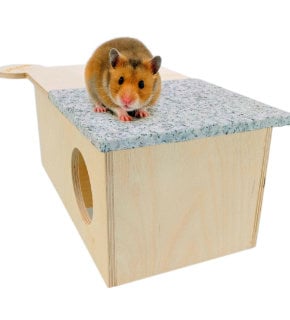 Golden hamsters need a spacious enclosure of at least 100 x 50 cm (LICG). A good enclosure gives the animals the opportunity to dig. In the wild, hamsters build beautiful tunnel systems and they want to continue doing so in captivity. A burrow in the wild is at a depth of at least 1 to 2 meters and is approximately 1 meter long. The depth of the burrow depends on the ambient temperature. If the temperature rises, the hamster will dig deeper underground to reach the cool earth, a kind of natural air conditioning.
Golden hamsters need a spacious enclosure of at least 100 x 50 cm (LICG). A good enclosure gives the animals the opportunity to dig. In the wild, hamsters build beautiful tunnel systems and they want to continue doing so in captivity. A burrow in the wild is at a depth of at least 1 to 2 meters and is approximately 1 meter long. The depth of the burrow depends on the ambient temperature. If the temperature rises, the hamster will dig deeper underground to reach the cool earth, a kind of natural air conditioning.
Hamsterscaping is therefore great fun for Syrian Hamsters.
In our home this translates into a spacious enclosure with digging possibilities! A terrarium is the best choice for this because of its closed character. It is important that a terrarium allows for good ventilation, so preferably has two grids (top and bottom). This is especially important in the summer when temperatures rise above 25°C.
Golden hamsters do not tolerate high temperatures in combination with high humidity, so a temperature between 20 - 24°C and a humidity below 70% is recommended. You can use a hygrometer to measure these values.
House for a Syrian Hamster
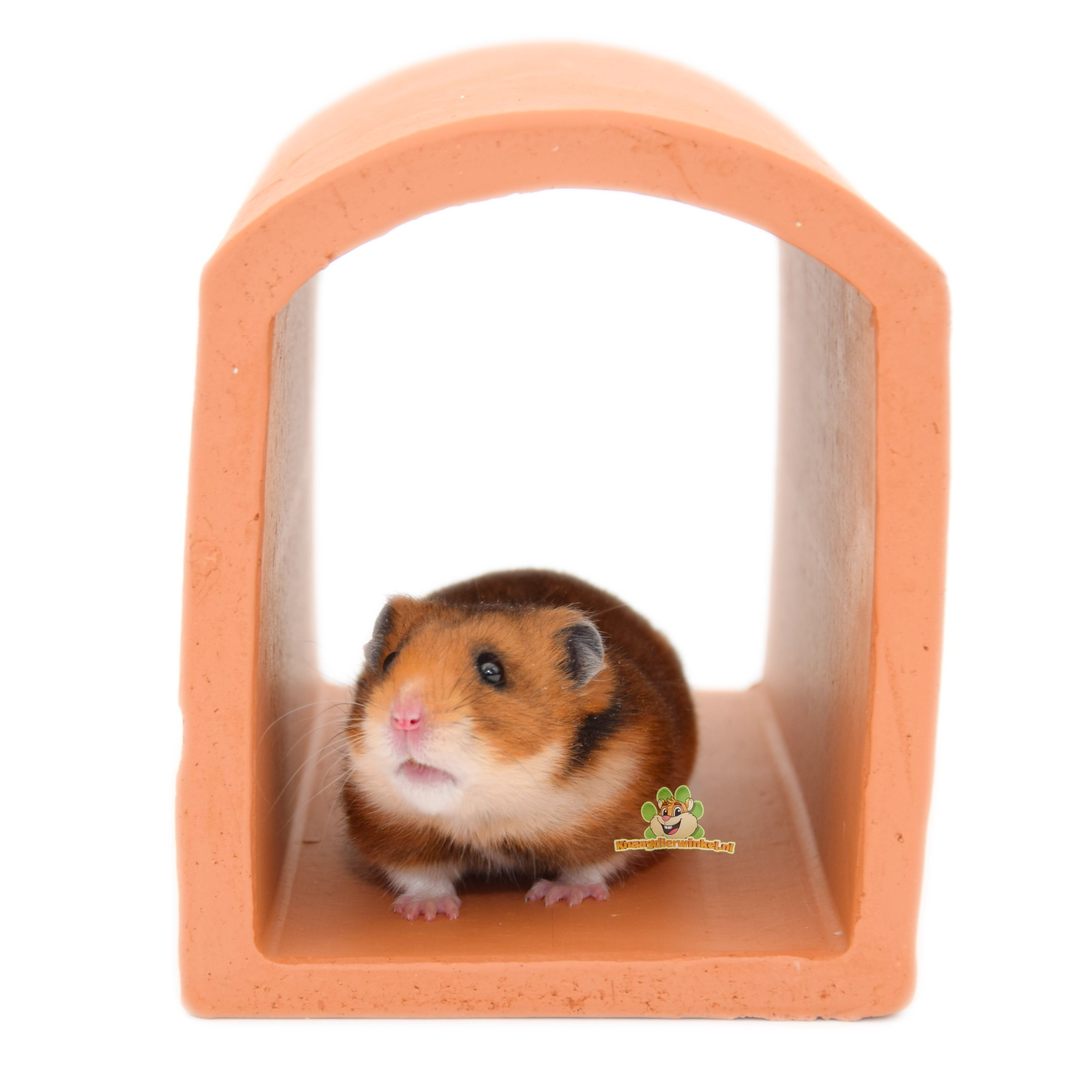 Syrian hamsters need a larger hamster house than dwarf hamsters. That sounds logical, but unfortunately manufacturers do not make a distinction here. Fortunately, we do. We use logos to indicate whether all houses are suitable for a Syrian hamster or only for a dwarf hamster. Syrian hamsters are prey animals and do not like to walk around the enclosure in the open, if they come across a shelter every now and then they feel a lot safer. Our advice is therefore to have at least two houses for the hamster. A house where the hamster can sleep and another where it can hide. At least one of the two houses must be larger so that the hamster can also store its food supplies in it. Not being able to put away the food supplies can cause stress for the animals.
Syrian hamsters need a larger hamster house than dwarf hamsters. That sounds logical, but unfortunately manufacturers do not make a distinction here. Fortunately, we do. We use logos to indicate whether all houses are suitable for a Syrian hamster or only for a dwarf hamster. Syrian hamsters are prey animals and do not like to walk around the enclosure in the open, if they come across a shelter every now and then they feel a lot safer. Our advice is therefore to have at least two houses for the hamster. A house where the hamster can sleep and another where it can hide. At least one of the two houses must be larger so that the hamster can also store its food supplies in it. Not being able to put away the food supplies can cause stress for the animals.
Exercise wheel for a Syrian hamster
The hamster wheel is a very important part of the furnishing of the hamster enclosure. Syrian hamsters are active animals that like to run at night. This is because they naturally run a lot during the night hours in search of food. This is in their DNA, so to speak. In addition, scientific research has shown that hamsters become happy from running in a wheel, digestion is promoted and the animals generally remain in good condition.
An exercise wheel for a Syrian hamster should have a diameter of at least 30 cm and consist of a solid running surface.
Bedding for Golden Hamsters
It is important that the substrate for hamsters is diggable, that is to say that they can make tunnels and holes in it, which preferably remain standing. This can be achieved by choosing substrate that is already diggable or by mixing substrates with each other so that they are diggable. Examples of diggable substrates are, for example, Humus and Cave Sand , but also Cotton & Cotton . A nice mix is, for example, the mix of Cotton & Hemp Fiber , Cotton & Wood Fiber or a mix of Wood Fiber , Hemp Fiber and Hay. Substrates such as Back 2 Nature are not suitable, because the animals cannot dig in them. An ideal height of the substrate for digging in is around 20 and 30 cm.

Long Haired Syrian Hamsters and Bedding
For the long-haired Golden hamsters, not every substrate is suitable because it can get tangled in the fur and cause matting. Depending on the thickness and density of the fur, substrates made of thicker material such as: Cotton, Paper or Humus/Cave sand are suitable.
It is also good to brush the coat of the longhair with some regularity. This can be done with a rodent brush, but a toothbrush is also very pleasant to use for this.
Sand Bath for Syrian Hamsters
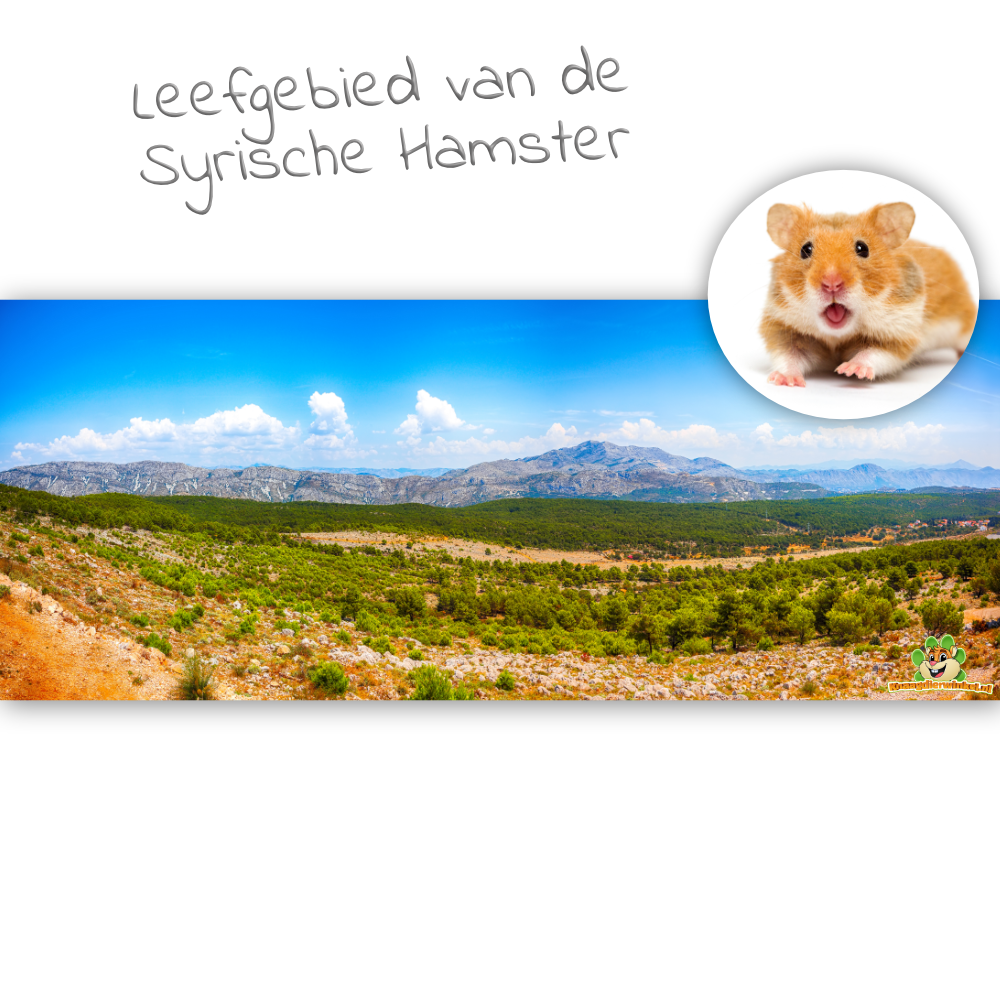 Syrian hamsters like to take a sand bath every now and then. Sand has a degreasing effect and therefore also a cooling effect. Because sand is degreasing, it also has a drying effect. Animals with skin problems should therefore not be given a sand bath. If the skin dries out too much due to the sand, it can start to itch, which causes the animals to bathe even more. It is therefore important to keep an eye on the hamsters' bathing behaviour and to remove the sand box if there are signs of skin problems (red spots, bald spots, scabs, wounds).
Syrian hamsters like to take a sand bath every now and then. Sand has a degreasing effect and therefore also a cooling effect. Because sand is degreasing, it also has a drying effect. Animals with skin problems should therefore not be given a sand bath. If the skin dries out too much due to the sand, it can start to itch, which causes the animals to bathe even more. It is therefore important to keep an eye on the hamsters' bathing behaviour and to remove the sand box if there are signs of skin problems (red spots, bald spots, scabs, wounds).
Hibernation in Syrian Hamsters
If the ambient temperature is below 15°C for a long time, the animals can go into hibernation. It is very important to recognize this well, because it is often thought that the animals have died with all the consequences. A hamster that is in hibernation feels cold and sometimes even a bit stiff. Take the animal in your hands and let it warm up in your hands and wake up.
Hibernation is triggered on the one hand by a drop in temperature, but on the other hand, food shortages can also play a role. If the animals are underfed and it is a bit colder, but warmer than 15°C, they can also go into hibernation. The length of the day also plays a role here. If it also starts to get dark at 17:00 for hamsters, the body can receive a signal that winter has started.
Syrian Hamsters are nest builders
Syrian Hamsters are real nest builders, they always need nesting material so they can line their hole. Making a nest is therefore part of the natural behavior of a hamster. Therefore always give the hamster 15-25 grams of nesting material.
Hamster nesting material should be soft, absorbent and have brittle fibres so that the animals cannot get tangled in it. Materials such as cotton, hemp, toilet paper and hay are ideal.
Syrian Hamster/Golden Hamster Food
Hamsters are granivores (seed eaters). The diet of Golden hamsters consists mainly of seeds and a small amount of vegetable food in the form of herbs , but also animal proteins. Hamsters catch small insects in the wild, so it is good if their diet also contains animal proteins.
Syrian Hamsters transport their hamster food in their cheek pouches. What you see is that the hamster stuffs its food in its cheek pouches and quickly takes it to its home or pantry. Transporting food in the cheek pouches is also called "Hoarding". Thanks to the cheek pouch muscle, the food is held in the cheek pouch and the hamster can transport it safely and quickly.
Dental formula: 1013/1013 (Ratio of upper to lower incisors = 1:2-3) Incisors continue to grow
Molars do not continue to grow: The large cheek pouches that extend to the shoulder blades are a flexible protrusion of the buccal mucosa.
Stomach: consists of two chambers: the foregut and glandular stomach
Small appendix: with limited ability to process crude fiber. Protein-rich appendix pellets are only eaten when food is scarce
The percentage of crude fiber in the diet should be a maximum of 10% for optimal digestibility and absorption of the diet.
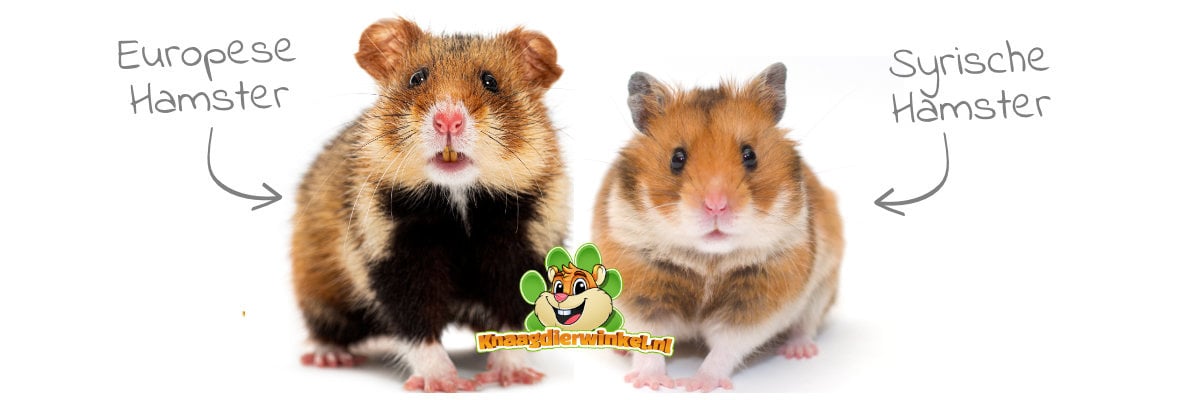
Gnawing material to wear down the teeth
Syrian Hamsters have a natural need to gnaw. This is because Hamsters are rodents and have continuously growing incisors. It is therefore necessary for Hamsters to be able to gnaw on something to wear down their teeth. If Hamsters have too few opportunities to wear down their teeth, the teeth can become too long or grow crooked with all the consequences that entails.
Rodents use gnawing wood to wear down their teeth. Because rodents' teeth are always growing, they need to have something to gnaw on regularly so that they don't grow too long and crooked.
Some hamsters gnaw very actively on gnawing wood and others not at all. On the one hand it is a matter of taste, but on the other hand it is a matter of need. If a hamster has no need to gnaw because its teeth remain long due to food, hay or other nibbles, then it will gnaw less on gnawing wood. It is good to always offer natural gnawing wood so that the animals can always gnaw when they have a need to gnaw.
Dental Problems in Hamsters
If you notice that your hamster is very enthusiastic about grabbing the food, but then does not eat it, then there may be something wrong with the teeth. Drooling can also indicate dental problems. If you suspect that there are dental problems, it is best to contact the vet.
Syrian Hamster Reproduction
Syrian Hamsters are solitary (live alone) and only come together during mating season. Once young are born, the mother takes care of them until they are old enough. Then they are chased away to go out into the wide world.
The female is willing (in heat) and ready to mate every 4 days. This lasts for about 12 hours. If a successful mating has taken place on these days, the young are born after about 18 days.
The difference between males and females can be seen in the distance between the genital opening and the anus. In a male this distance is greater than in a female.
Sexually mature : females after 4-6 weeks, males after 6-7 weeks
Breeding ready : females after 8 - 10 weeks, males after 10-12 weeks
Number of litters : 3-4 per year
Litter size : 7 (max. 12) young ones per litter
Gestation period : 15-18 days
Birth weight : 2-3 g, nestlings
Weaning time : from week 4
Syrian Hamster Health
Syrian hamsters are generally healthy animals. The most common health problems are dental problems and diarrhea (wet tail). We therefore recommend regularly checking the teeth of the animals to discover any dental problems in time. To prevent digestive problems, a good balanced and complete hamster food is essential.
Young golden hamsters can transmit LCM pathogens to humans. Be careful with pregnant women.
It is not necessary to treat the animals preventively with anti-parasite. Giving extra vitamins is not necessary with a complete hamster food.
It is advisable to consult a veterinarian if you experience the following symptoms:
Dental problems
Drooling, runny nose and eyes, protruding teeth, not eating, losing weight, eating foreign materials that are softer than food.
Skin
Bald spots, lots of scratching, scabs, wounds, bumps and lumps
Other
Wet and dirty bottom, drinking a lot, falling over, listlessness, different shape and color of the droppings



